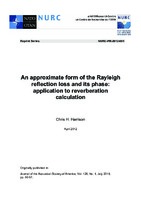| dc.contributor.author | Harrison, Chris H. | |
| dc.date.accessioned | 2018-10-11T14:09:42Z | |
| dc.date.available | 2018-10-11T14:09:42Z | |
| dc.date.issued | 2012/04 | |
| dc.identifier | 42932 | |
| dc.identifier.govdoc | NURC-PR-2012-001 | |
| dc.identifier.uri | http://hdl.handle.net/20.500.12489/663 | |
| dc.description.abstract | A useful approximation to the Rayleigh reflection coefficient for two half-spaces composed of water over sediment is derived. This exhibits dependence on angle that may deviate considerably from linear in the interval between grazing and critical. It shows that the non-linearity can be expressed as a separate function that multiplies the linear loss coefficient. This non-linearity term depends only on sediment density and does not depend on sediment sound speed or volume absorption. The non-linearity term tends to unity, i.e., the reflection loss becomes effectively linear, when the density ratio is about 1.27. The reflection phase in the same approximation leads to the well-known "effective depth" and "lateral shift." A class of closed-form reverberation (and signal-toreverberation) expressions has already been developed _C. H. Harrison, J. Acoust. Soc. Am. 114, 2744-2756 (2003); C. H. Harrison, J. Comput. Acoust. 13, 317-340 (2005); C. H. Harrison, IEEE J. Ocean. Eng. 30, 660-675 (2005). The findings of this paper enable one to convert these reverberation expressions from simple linear loss to more general reflecting environments. Correction curves are calculated in terms of sediment density. These curves are applied to a test case taken from a recent ONR-funded Reverberation Workshop. | |
| dc.format | 8 p. : ill. (digital, PDF file) | |
| dc.language | English | |
| dc.publisher | NURC | |
| dc.source | In: Journal of the Acoustical Society of America, Vol. 128, No. 1, July 2010, pp. 50-57. | |
| dc.subject | Acoustic reflection | |
| dc.subject | Acoustic reflection loss | |
| dc.title | An approximate form of the Rayleigh reflection loss and its phase: application to reverberation calculation | |
| dc.type | Reprint (PR) | |
| dc.type | Papers and Articles | |
